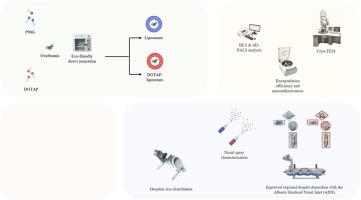Liposomal sprays for nasal vaccination: a comparative study of cationic and anionic formulations involving stability upon nebulization, sprayability, and in vitro immune activation
IF 4.9
3区 医学
Q1 PHARMACOLOGY & PHARMACY
Journal of Drug Delivery Science and Technology
Pub Date : 2025-09-06
DOI:10.1016/j.jddst.2025.107498
引用次数: 0
Abstract
Nasal immunization is a promising non-invasive route, enabling needle-free self-administration and activating immune cells in the mucosal tissue of the upper airways. This vaccination method is particularly appealing when paired with biocompatible and biodegradable nanocarriers like liposomes, which serve as an effective tool for the nasal delivery of antigenic molecules. In the present study, the model antigen ovalbumin was encapsulated in liposomes using an eco-friendly method. Negative and positive liposomes were formulated with Phospholipon® 90 G alone (anionic liposomes) or combined with 1,2-dioleoyl-3-trimethylammonium-propane (cationic DOTAP-liposomes). These liposomes were smaller than 130 nm and remained stable for up to 3 months. Their sprayability was assessed based on criteria established by the European Medicines Agency and the Food and Drug Administration for nasal products. Both formulations were easily sprayable, generating droplets larger than 5 μm, which are expected to deposit in the nose while avoiding the lungs. Furthermore, after nebulization, they retained their dimensions, structures, and high encapsulation efficiencies (>70 %). In a co-culture system of dendritic cells and B3Z OT-I hybridoma cells, it was shown that they enhanced antigen delivery and presentation, producing approximately 6–9 times more interleukin-2 compared to the ovalbumin solution. Lastly, when tested on macrophages, they did not induce any proinflammatory effect. However, due to their higher muco-adhesiveness (∼88 % vs ∼8 %) and better deposition in the posterior nasal cavity (∼52 % vs ∼43 %) compared to anionic liposomes, cationic DOTAP-liposomes appeared more suitable for nasal administration.

用于鼻腔疫苗接种的脂质体喷雾剂:阳离子和阴离子制剂的比较研究,涉及雾化稳定性,可喷雾性和体外免疫激活
鼻免疫是一种很有前途的非侵入性途径,可以实现无针自我给药和激活上呼吸道粘膜组织中的免疫细胞。当与生物相容性和可生物降解的纳米载体(如脂质体)配对时,这种疫苗接种方法尤其具有吸引力,脂质体可作为鼻腔递送抗原分子的有效工具。本研究采用生态友好的方法将模型抗原卵清蛋白包封在脂质体中。阴性和阳性脂质体分别与Phospholipon®90g单独(阴离子脂质体)或与1,2-二酰-3-三甲基丙烷(阳离子dotap -脂质体)联合配制。这些脂质体小于130 nm,并保持稳定长达3个月。它们的喷雾性是根据欧洲药品管理局和食品药品管理局为鼻用产品制定的标准进行评估的。这两种配方都很容易喷射,产生的液滴大于5 μm,预计这些液滴会在鼻腔内沉积,而不会进入肺部。此外,雾化后,它们保持了其尺寸,结构和高封装效率(> 70%)。在树突状细胞和B3Z OT-I杂交瘤细胞的共培养系统中,研究表明它们增强了抗原的传递和呈递,产生的白细胞介素-2比卵清蛋白溶液多约6-9倍。最后,当对巨噬细胞进行测试时,它们没有诱导任何促炎作用。然而,与阴离子脂质体相比,阳离子dotap -脂质体具有更高的黏附性(~ 88%对~ 8%)和更好的后鼻腔沉积(~ 52%对~ 43%),因此更适合鼻腔给药。
本文章由计算机程序翻译,如有差异,请以英文原文为准。
求助全文
约1分钟内获得全文
求助全文
来源期刊
CiteScore
8.00
自引率
8.00%
发文量
879
审稿时长
94 days
期刊介绍:
The Journal of Drug Delivery Science and Technology is an international journal devoted to drug delivery and pharmaceutical technology. The journal covers all innovative aspects of all pharmaceutical dosage forms and the most advanced research on controlled release, bioavailability and drug absorption, nanomedicines, gene delivery, tissue engineering, etc. Hot topics, related to manufacturing processes and quality control, are also welcomed.

 求助内容:
求助内容: 应助结果提醒方式:
应助结果提醒方式:


